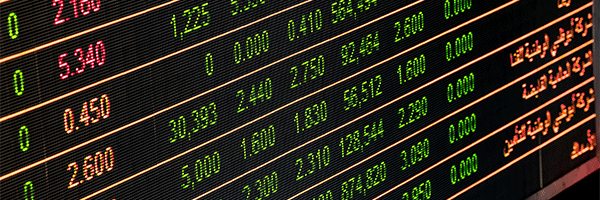
Federal Reserve says it is staying the course, for now
No change. But change coming someday. (Not soon, though.) That was the message from today’s meeting of the Federal Reserve’s Open Market Committee.

No change. But change coming someday. (Not soon, though.) That was the message from today’s meeting of the Federal Reserve’s Open Market Committee.

After picking up; 1.3% yesterday, shares of Microsoft added 1.23% today, Friday, July 23, as Wall Street analysts raised earnings estimates ahead of the company’s July 27 earnings report. It’s a tried and true earnings season game: No analyst wants to be on the wrong side of a strong earnings report so the days before a company is due to report earnings brings a raft of new, higher target prices.
The Standard & Poor’s 500 closed up 0.20% today, July 22. The Dow Jones Industrial Average squeezed out a 0.07% gain. But if you were looking for bigger upside moves, turn your eyes to the technology sector.

The big arguments in the financial markets these days are about inflation–will it stay elevated at an annual rate of the better than 5% reported in May and June or will be fall to the 2.5% or so envisioned by the Federal Reserve–and interest rates–the yield on the 10-year Treasury fell to 1.21% on Monday, July 19 and some market strategists see 1% in the cards while others are looking for a 2.5% or even 4% at the peak of this cycle. I certainly won’t pretend the results of these arguments don’t matter. Inflation sentiment and interest rate projections are the two biggest drivers of stock and bond prices right now. (Well, maybe in the short term next to worries that a fourth wave in the pandemic will shut down the U.S. and global economies again.) But these arguments matter rather less than you might think to investors saving for retirement and those looking to generate some income from their portfolio either to fund retirement or some other predictable big ticket item (like monthly mortgage payments on a first or second (don’t I wish) home.) That’s because from that perspective the results of these arguments don’t change the portfolio cash flow picture very much

Today investors and traders ran to buy all the re-opening, post-vaccine recovery, cyclical stocks that they dumped yesterday. Macy’s (M) is up 4.29% as of 3:30 p.m. New York time after plunging 4.90% yesterday. Amusement park operator Cedar Fair (FUN) is up 4.12%. Cyclical Dupont (DD) is up 1.34% after closing down 4.46% yesterday. Carnival Cruise (CCL) is ahead 7.83% today after dropping 5.74% yesterday. It’s as if the market has decided that the really scary upward trend in new infections from the spread of the Delta variant is done with and over. Pandemic yesterday. No pandemic today.. The figures from the pandemic front say otherwise. The 14-day change in new cases as of July 19 is 198%. The 14-day change in new deaths is 44%.
U.S. retail sales surged 18.0% in June from June 2020, the Commerce Department reported today. Demand for goods remained strong but spending is clearly shifting back to services. Stocks fell despite the good news with economic recovery and post-vaccine stocks taking the biggest hit. The Consumer Discretionary Select Sector SPDR ETF (XLY) fell 1.23% on the day. The Consumer Staples Select Sector SPDR ETF (XLP) gained 0.20%.

China’s economy grew by 7.9% in the second quarter of 2021 from the second quarter of 2020. That was a huge slowdown from the 18.3% year over year growth in the first quarter. No one had expected that growth surge from the end of pandemic lockdowns to be duplicated this quarter. Before the report economists surveyed by Reuters were looking for GDP to grow by 8.1% in the quarter. So today’s report contains a slight miss on projections but it is be no means a worst case scenario, especially since other economic numbers were stronger than the GDP reading.

I’m starting up my videos on JubakAM.com again–this time using YouTube as a platform.
My thirty-third YouTube video “Inflation is here–listen to Pepsi and Conagra” went up today.

The Federal Reserve has said that the current jump in inflation is temporary, a result of post-pandemic glitches in the supply chain. So far the market is going along with that view. But huge jumps in monthly inflation in May and now, this morning, June are treating that confidence.
The consumer price index (CPI) rose 0.9% in June from May and by 5.4% from June 2020, according to the Labor Department today. Excluding more volatile food and energy components, core CPI inflation rose by 4.5% from June 2020. That’s the biggest jump in core inflation since November 1991.
The announcement last week by the People’s Bank of China that it would cut the reserve requirement for China’s big banks by 50 basis points has led to fears that China’s economy might be slowing from its peak pandemic growth rate. While economists had been expecting the move from the People’s Bank, they weren’t expecting such as large cut so soon. Which has led to fears the the People’s Bank moved so aggressively because China’s growth rate is slowing. Data on second quarter GDP is due to be released on Thursday and economists are expecting that growth in the quarter slowed to 8% from the record gain of 18.3% in the first quarter, according to a Bloomberg survey of economists. Growth in retail sales, industrial production, and fixed asset investment is expected to moderate too.

Stocks rallied today and bond prices moved higher (sending bond yields lower) on news that China People’s Bank and the European Central Bank would both pursue monetary moves to bolster growth. The People’s bank reduced the amount of cash that banks have to hold in reserve by 0.5 percentage points. That will send about 1 trillion yuan ($154 billion) in liquidity into the economy. The reduction in the reserve ratio was larger than most economists had projected. China is set to announced second quarter GDP figures in the coming week and the strength and accelerated timing of the move fed speculation that the numbers will show weaker than expected economic growth. The European Central Bank shifted its inflation target to 2% rom the prior “below, but close to, 2%.” The move signaled that the ECB, like the U.S. Federal Reserve, would be willing to tolerate higher inflation in the short term rather than endanger economic growth by raising interest rates. The central banks move–plus a week of selling of cynical stocks, led to a solid rally today

Initial claims for unemployment in regular state programs rose by 2,000 to 373,000 for the week ended July 3, the Labor Department reported today. Economists surveyed by Bloomberg were looking for initial claims to drop to 350,000. Now this may be disappointing to those hoping for evidence that the recovery from the pandemic recession nearly complete and that the economy is going from one strength to the next, but the data are a very thin reed to use to support headlines about growth worries in the economy like those I’ve seen today.